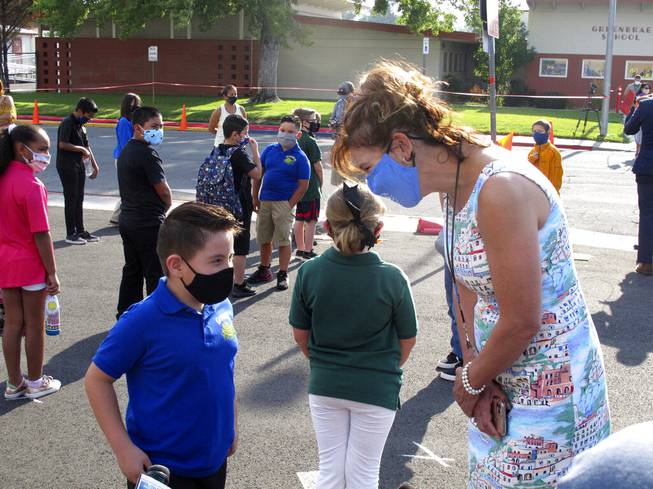
Scott Sonner / AP
In this Aug. 18, 2020, file photo, Washoe County Schools Superintendent Kristen McNeill talks to students returning to Greenbrae Elementary School in Sparks, Nev., for the first time since March with mandatory masks to help guard against the spread of the coronavirus.
Thursday, Dec. 10, 2020 | 2:56 p.m.
RENO — Convinced that in-person teaching is not a significant contributor to the spread of the coronavirus, Nevada’s school superintendent is urging state leaders to develop specific criteria to help guide county decisions about reopening classrooms.
Superintendent Jhone Ebert said her desire to return to in-class instruction as soon as possible is driven largely by concerns about disparities in academic achievement between higher-income and lower-income students taught strictly through distance learning.
“Data increasingly shows the best way to protect teachers and students is not to shut down, but focus on measures to keep everyone safe in classrooms,” Ebert told the state’s COVID-19 Mitigation Task Force last week.
“We should only consider complete closures under the most dire situations," she said.
Democratic Gov. Steve Sisolak has left decisions to reopen classrooms in the hands of individual counties.
Clark County issued a draft plan in Las Vegas last month to allow some in-class instruction for the first time this school year, but rescinded it and decided to stick with distance learning at least into January.
Washoe County continues to provide classroom teaching options at elementary schools in Reno-Sparks as it has since August, but two weeks ago suspended its hybrid program mixing both in-class and distance learning for secondary schools. This week it postponed a planned return to the hybrid model from Jan. 4 to at least Jan. 19.
“We know that the best place for our students is in school,” Washoe School Board President Malena Raymond said. “But we felt we needed more time to ensure these supports would be in place when they did return to our school sites and decided to extend the timeline for temporary distance learning for our middle school and high school students.”
Five rural counties continue to offer in-person learning to all students — Esmeralda, Eureka, Lincoln, Pershing and White Pine. Elko County has been transitioning to a hybrid plan in recent weeks. The rest currently combine classroom and distance learning
Ebert said with the exception of ages 15-19, driven largely by the 18-19 group, statistics show Clark County with its closed classrooms had a higher per capita rate of cases for all other school-age groups than Washoe County.
She acknowledged that since Aug. 10, Washoe’s per capita rate is higher than Clark for school-age kids.
But she said that during that period, 73% of all Nevada’s cases have been in Clark County compared to 20% in Washoe County. And among school-aged children, 71% have been in Clark and 21% in Washoe.
“That implies higher rates in Washoe are consistent with all age groups and not an indicator of in-school spread,” Ebert said.
Nevada’s teacher’s union has established “safe best practices and health guidelines” but has opposed what it sees as a rush to reopen classrooms and condemned Sisolak’s recent declaration allowing hiring of substitute teachers with no college education.
“Educators want to return to our classrooms and school sites more than anyone, but we’ve consistently said that the key to the safe operation of school buildings is slowing the spread of COVID in our communities,” Nevada State Education Association spokesman Alexander Marks said.
“We are seeing record cases almost every day, as hospitalizations continue to increase. We are nowhere near the CDC’s recommendation of a 5% positivity rate for re-opening for in-person instruction in school buildings,” he wrote in an email Thursday to AP.
He said that last week, children younger than 9 years old represented the greatest percentage increase in new Washoe County infection cases.
Ebert said data showing a growing disparity between “haves and have-nots” has increased her concern about remote teaching.
“Students in high-middle zip codes progress’ in math achievement continue to move up, while students in low zip codes areas, their achievement is going down,” she said.
Ebert advocates developing specific metrics for schools similar to those used to flag counties with high COVID-19 transmission rates in various categories as a guide for business closures and limits on public gatherings.
California, Oregon, Hawaii, New Mexico and North Carolina are among states that have adopted such school metrics.
Nevada’s COVID-19 Response Director Caleb Cage told Ebert last week it’s “something we can definitely engage in.”
“Gov. Sisolak has made a point of prioritizing keeping students in class," he said.
